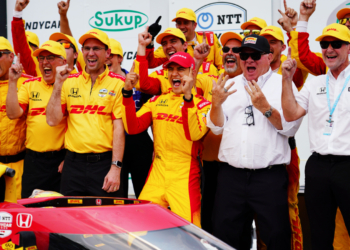I don’t like to make generalisations and sweeping assumptions but it would be fair to say that we tend to be quite divisive when it comes to having an opinion on almost anything at the moment.
Sitting on the fence is boring afterall. So I suppose you might be a bit disappointed to hear that my thoughts are neutral on the highly anticipated 2021 preliminary engine regulations released last week.
Even after some reflection, I see positives and negatives in them; I have no overriding opinion on them; I understand the thinking behind them.
Before we get into the key details, it’s worth reminding ourselves that Liberty Media have created a team of people (with no less than Ross Brawn at the helm) to come up with ideas – that incorporate the views of all those with interests in F1 – to shape the future of the sport on the technical front.
F1 must also start thinking sustainably too, as the Bernie Ecclestone regime has left the sport disjointed in so many areas. Some stability is needed to not only lure in new fans, teams/manufacturers and circuits, but also to retain the existing ones who are perhaps a little irritated with all too frequent knee-jerk reactions and half-arsed solutions.

With this in mind, the new regulations were never going to be a complete overhaul on the ones we have now. Hybrid power is here to stay: not only is it road relevant, it’s also vastly more powerful than any other powertrain that has gone before it and a step back from this concept would look a bit daft.
Road relevance in F1 is a popular debate, but for me it makes total sense. Put simply, car manufacturers are in F1 for its global advertising board, and there’s no better way of selling an automotive product than developing and utilising the technology inside it to racing success.
If you’re buying a McLaren or a Ferrari or an Aston Martin (brands that are all currently involved in F1), you want to be driving around in something with racing pedigree to a certain extent.
So here’s the main list of features:
– 1.6 litre, V6 Turbo Hybrid, revving to 18,000 rpm
– Prescriptive internal design parameters to restrict development costs and discourage extreme designs and running conditions
– Removal of the MGU-H; More powerful MGU-K with focus on manual driver deployment together with option to save up energy for tactical racing
– Single turbo with dimensional constraints and weight limits
– Standard energy store and control electronics
– High Level of external prescriptive design to allow easy engine/chassis/transmission swapping
– Tighter fuel regulations and limits on number of fuels used per season
At first glance not an awful lot has changed, which is true from an architectural perspective. Low capacity V6, turbocharged, hybrid technology: all the ingredients from the past four seasons that will continue to intrigue outside manufacturers (Ilmor and Cosworth are the latest to express an interest).
The overall package will take up virtually the same amount of space within the car as it does now, so there is less to worry about regarding chassis integration and vehicle dynamics.
Now onto the differences. Cost cutting has been at the forefront of recent meetings between teams and the FIA, and the 2021 rules reflect that too. The MGU-H – responsible for the harvesting of energy from the exhaust gases via the turbocharger at high speed – operates under extreme temperature and loading conditions and is thus an incredibly expensive part to develop.

Mercedes were the first to find significant advantages in placing it in the middle of the V of the engine, separating the turbine and compressor sides of the turbo. Over the years Ferrari, Renault and Honda have followed suit to some degree. A lot of resources are thrown at it to ensure that it performs reliably, which over time has led to increasing complexity in this area. It is a huge deterrent for outsiders looking to enter the sport, which the sport’s governing body have duly recognised and have taken action by abolishing it.
Noise levels will be given a boost thanks to the deletion of the MGU-H (which essentially limits the exhaust flow through the turbo) and also a higher rev limit, although the detail within that will once again lie in fuel flow restrictions.
The current engines are allowed to reach 15,000rpm, but we never see (or indeed hear) this due to the maximum 100kg/hr fuel flow rate occurring from 12,500rpm upwards. If the FIA are sensible, we will be gaining a few more decibels and a slightly brighter tone from the engine in the future. This will have its own drawbacks though, which I will explain later.
Standard parts are also a big plus for smaller suppliers looking for a way in, and with them comes the ability to interchange different elements of the powertrain easily. This, coupled with the dimension and weight restrictions in certain areas, will allow teams to quickly swap to a different supplier if the circumstances arise.
If the FIA are sensible, we will be gaining a few more decibels and a slightly brighter engine tone
However, delve into the details and it is easy to understand why Renault and Mercedes in particular are not in favour of the changes. Discussion surrounds the MGU-H once more: forming an integral part of the power unit, it is responsible for harvesting 60 per cent of the car’s electrical energy, which can then be stored, used to spool the turbo at low speed or be directed straight to the MGU-K. In essence, it is what makes these powerful engines with huge turbos so driveable and incredibly efficient. Ditching the ‘H’ would place extra reliance on the ‘K’ to accelerate the car, which generates less energy and would therefore have limited use.
The next issue regards the turbocharger. With constraints, I imagine it will be smaller than what we have now simply because it wouldn’t be possible to control the lag without the MGU-H. As there is a flow restriction through the turbine, the rotational speed will be slower and the compressor will not be able to pull in as much air. This will significantly alter the lean burn combustion process and we haven’t yet considered the higher rev limit.

Additional revs are all well and good but with them comes higher fuel burn. The cars will have to carry more fuel from the start of the race, which on top of the Halo, wider tyres and longer wheelbases will make them pretty burly to say the least.
Furthermore, the engine components will have to deal with the higher heat and stresses that come with running at a faster speed, and more durability normally equates to more weight. More mass is less efficient and, in my opinion, considerably hampers racing.
And then there’s the biggest argument of them all, presented recently by Ferrari, which is uniqueness. While many other racing series’ utilise standard parts very well, F1 should be careful not to head too far down this path. The individuality of the engineering in the cars is part of what makes the sport so appealing – you don’t even have to fully understand the technical side of the sport to know that. Personally I’d rather see a budget cap than a standardising frenzy, but that’s another debate for another time.
What happens now? More discussion I suspect, as the FIA struggles to satisfy both the potential newcomers and the current crowd. In years gone by I’ve had little faith in those in charge of implementing new rules, but this time around I feel (ever so slightly) confident that Brawn can steady the ship and find the best compromise for everyone. Enjoy the inevitable debate.






